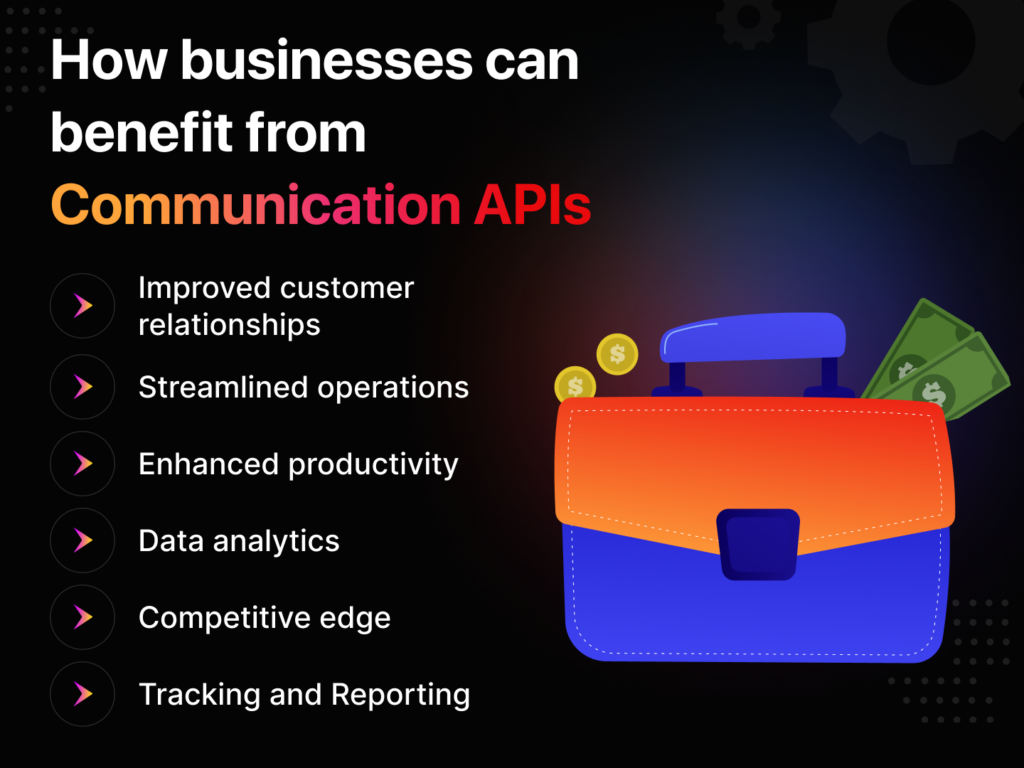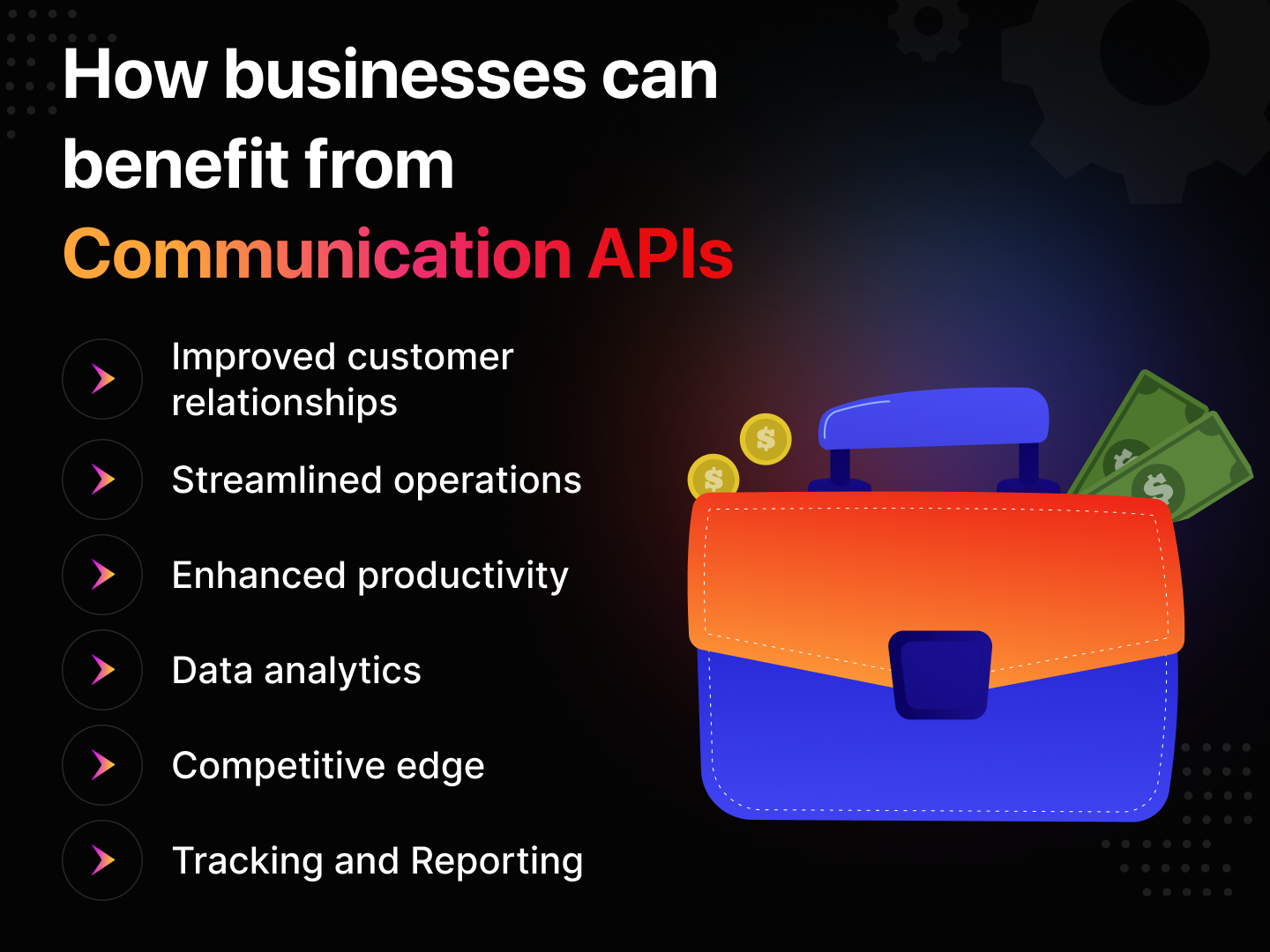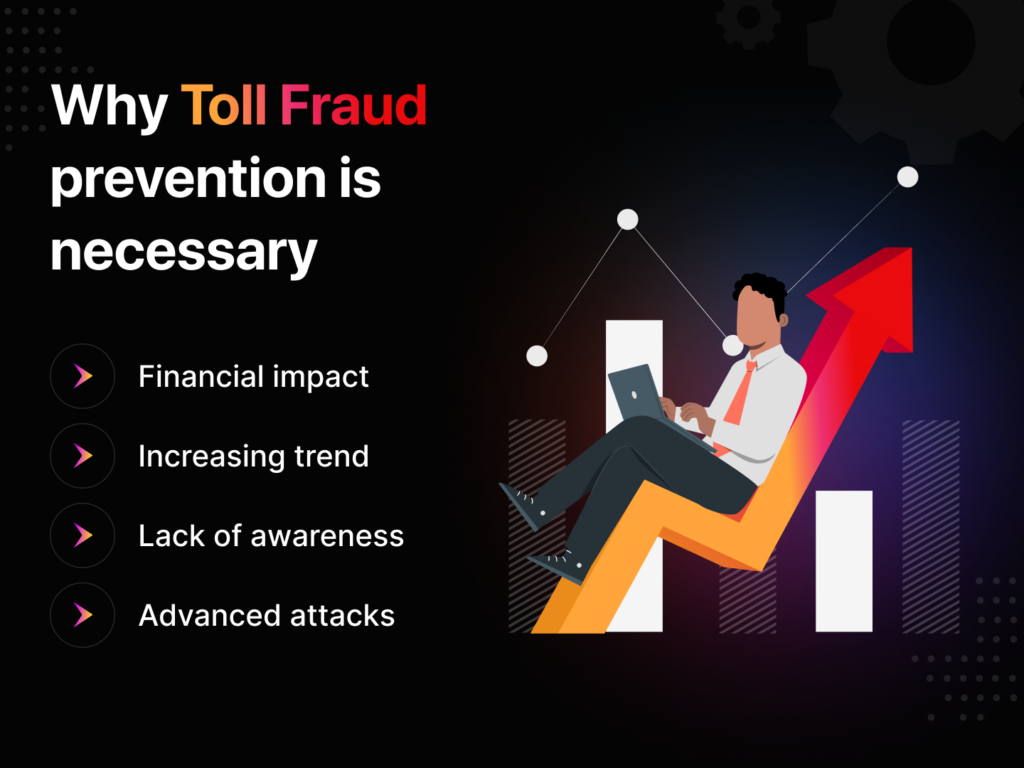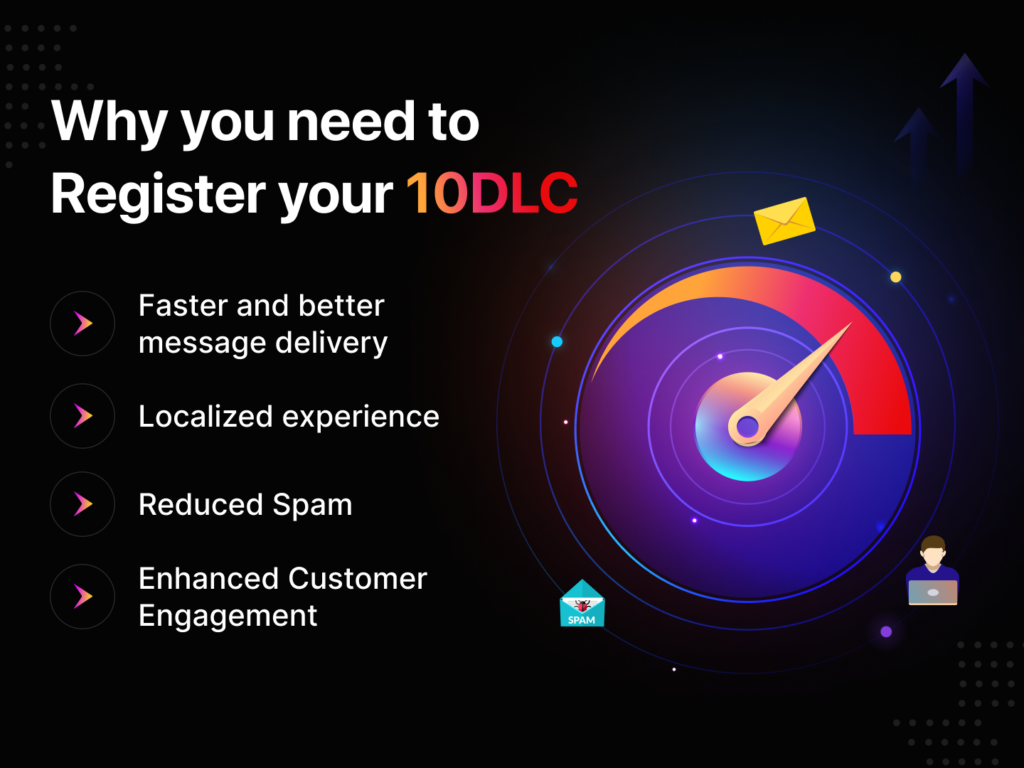Communication APIs simplify connecting and communicating, which ultimately improves collaboration and relationships with customers.

However, before integrating them into your business plan, it’s crucial to identify prevalent misconceptions and be aware of potential issues.
We’ll go through the notion of Communication APIs, the different types of APIs, and their use cases and functionalities they offer to both businesses and employees.
What are communication APIs?
Communication APIs assist developers in integrating different communication platforms into their applications or software solutions.
They link multiple systems simultaneously to transfer data in real-time.
Consider communication APIs to be a universal language that the different software applications use to converse with each other seamlessly.
APIs use precise standards or protocols (such as HTTP or HTTPS) that define how data should be sent and received to make this connection consistent.
These tools are extremely adaptable, allowing you to add text, audio, or video conversations to your app or website. They can also send notifications, manage chatbots, and offer customer assistance.
How do they work?
For example, when a mobile app needs to get information or carry out certain actions on a web-based service (like sending a message or fetching data), it sends this request over a Communication API, which handles the request and sends back the necessary information or instructions to the app.
These are the essential functions of communication APIs:
- Enabling connectivity: Communication APIs allow various software components, such as messaging applications or customer support tools, to communicate and function in tandem. These systems, for example, how the weather app gets data or how you apply for a passport, require communication to carry out these processes.
- Standardized communication: APIs set communication rules and protocols, specifying what information must be transferred, how to deliver it, and what replies to expect.
- Efficiency and time savings: Using communication APIs saves developers a lot of time and effort, so instead of creating interfaces from scratch, companies can use the pre-existing APIs to simplify and speed up production.
- Versatile functions: Communication APIs offer various functions such as voice-related options like call routing and recording conversations and messaging services like SMS and MMS that can help developers design their products to satisfy all requirements.
- Integration of various software systems: APIs allow easy integration of numerous software systems.A Customer Relationship Management (CRM) tool can connect to a messaging platform through API, ensuring customer interactions are recorded and managed accurately.
- API documentation: To use an API, developers rely on documentation given by the API provider.
- Security: To access the system, APIs often require an API key, a unique identification for the application, and guarantees that only authorized apps can communicate with the API, protecting sensitive data and resources.
Types of communication APIs
Text Message API
A Text Message API is a general name for various protocols responsible for the interchange of text messages, like SMS, MMS, instant messaging (such as WhatsApp, Facebook Messenger, or Slack), and email messages.
SMS API
This tool assists developers in integrating SMS features into their applications, giving companies direct and quick access to the SMS gateway, resulting in greater message reliability and speed., allowing them to send hundreds of messages to their target recipients in seconds, guaranteeing fast and trustworthy delivery.
Bulk SMS marketing is extremely valuable for businesses due to its cost-effectiveness and high open rates.
MMS API
Similarly to SMS, the MMS API allows applications, websites, CRMs, and apps to send texts and multimedia content like images, videos, GIFs, audio, and other formats.
MMS API’s features are frequently used by developers that want to add visual elements to their apps; people use it if they want to express themselves in a more visually attractive way, and organizations that want to connect with their clients through innovative marketing for new product launches, quizzes, etc.
Email API
An email API connects multiple apps to an email platform’s features and capabilities by generating and sending transactional emails, updating email templates, and giving access to email performance data.
While many apps rely on the basic SMTP (Simple Mail Transfer Protocol) for email delivery, email APIs offer developers a more reliable and programmable approach to email-related functions beyond standard email protocols’ restrictions.
Voice APIs
A voice API allows robots to read human spoken commands and create replicated human speech, improving communication between computers and people.
It can be used for various purposes like automated customer service, reading content for customers with visual impairments, and other types of interactive help.
Social Media APIs
A Social Media API is used to connect social media platforms like Facebook, Twitter, and Instagram to other software, tools, or mobile apps for monitoring comments, mentions, and conversations; schedule posts; allow customers to sign in to their social media platforms, etc.
Businesses can use them to find potential influencers who might be interested in teaming up for marketing campaigns, check the performance of their marketing strategies, and gather content from different social media platforms to keep their audience engaged.
API integration examples and case studies
Restaurant ordering system
A restaurant that wants to set up an online ordering system that can safely accept online payments using a third-party payment gateway API.
They may also include a messaging API to send customers SMS or email order confirmations and updates.
Social media login integration
Users can sign in to websites and applications using their Google or Facebook account credentials.
When a user logs in using their Google or Facebook account, the website or app uses the relevant social network APIs to authenticate the user and access their basic profile information, making the registration and login process easier.
Apple iOS API for touchscreen interactions
The iOS API from Apple offers developers tools for creating touch-sensitive interactions in mobile apps.
Touch controls for a game can be created using iOS APIs so that players can interact with the game world through gestures and taps.
Google Maps integration
A mobile app must include maps and location-based services by using features like showing maps, receiving directions, and accessing the user’s current location to give area-specific information and services by integrating Google Maps APIs.
Label conversion API for shipping labels
An e-commerce website generates shipping labels in ZPL format but has to display them to clients as PNG pictures.
The website can use a label conversion API to convert ZPL-format labels into PNG images, making it easier to display shipping labels within a web browser and improving the overall user experience.
Stock price API for financial data
A financial analysis application needs up-to-date stock price data.
The app can retrieve real-time or historical stock price information for specified companies using a stock price API. This information can also be used to create charts and graphs for analysis.
Inventory management and online sales integration
An e-commerce company manages physical and online sales channels through APIs to automate inventory management.
The associated point-of-sale systems use APIs to update inventory information when a product is sold online or in-store. APIs can also be used to synchronize product availability across many online marketplaces.
How businesses can benefit from communication APIs
Improved customer relationships
Businesses can engage with customers in real-time through communication APIs like WhatsApp Business API and strengthen their relationships by sending personalized messages, providing automated support, and maintaining secure and private conversations.
Streamlined operations
Businesses can reduce human labor by automating operations like message sending and media sharing, improving productivity, and ensuring communication works with current systems, resulting in a more cohesive process.
Enhanced productivity
API automation features, like WhatsApp API, boost productivity by managing tasks so businesses can instantly interact with customers, saving resources and time.
Scalability
APIs can handle the load so companies can expand without worrying about infrastructure limitations, helping them manage a rise in client contacts, whether a few messages or millions.
Data Analytics
These APIs offer valuable data analytics for strategy refinement, helping companies track customer interactions and responses, including other essential metrics while making choices to improve their communication strategies.
Customization
APIs come with various customization options so businesses can modify their messages to the target audience, allowing their communication strategies to adapt to diverse contexts.
Competitive edge
In 2023, implementing APIs is critical for succeeding in the competitive market. Adding communication APIs, like the WhatsApp Business API, into a business’s strategy offers an edge over competitors so companies can contact customers through their preferred channels.
Innovation and speed
Ultimately, APIs are about innovation, helping businesses use external resources, speeding development, and cutting expenses to deliver new features and services faster.
Cost savings
Saving money by avoiding the costs of developing and maintaining in-house functionality helps businesses take advantage of the skills and infrastructure of API providers, paying only for the used services.
Tracking and reporting
These solutions include tracking and reporting features so businesses can monitor the status and message delivery, helping them analyze the performance of their marketing campaigns when making adjustments.
Communication API Challenges: What you need to know:
Using and implementing APIs can get quite complex for several reasons, mainly because you need to adjust your internal systems, procedures, how you manage data, your security protocols, and even the structures you have in place for governing your processes.
To deal with this complexity, your business must plan thoroughly and carefully analyze how the API implementation will influence each department.
Security concerns
APIs hosted in cloud environments can be susceptible to security breaches. Cybersecurity and Infrastructure Security Agency discusses the best practices for securing APIs in cloud environments.
Preventing these risks requires prioritizing data security immediately and remaining vigilant as your project expands.
It’s recommended to employ a specialized security team that can work on improving your security.
Financial and time considerations
Integrating communication APIs can be costly, especially in the early stages, and you might not immediately see the benefits.
Also, you must consider ongoing maintenance and management as they come with additional costs.
Dealing with these financial concerns demands choosing an API model that aligns with your business needs and collaborating with experienced providers that effectively manage expenses.
Employee hesitance
Employees may be hesitant to use APIs if they don’t understand how it affects their daily work. Some might prefer sticking to what they already know instead of learning something new, which is why you’ll need a team of experts who understand APIs when starting a project.
This demands the recruiting of experts and developers who can teach API basics through various modules.
Challenges with compatibility
A mobile app must include maps and location-based services by using features like showing maps, receiving directions, and accessing the user’s current location to give area-specific information and services by integrating Google Maps APIs.
Version control and updates
API changes over time, like upgrades and version adjustments, can cause compatibility difficulties, so version control must always be managed timely.
Authentication and security
One challenging component of APIs is ensuring a safe entry via advanced and time-consuming authentication and authorization processes.
Documentation and support
One of the biggest problems when connecting different computer systems using APIs is unclear instructions.
When we don’t have these instructions, figuring out how the system works, what information it gives us, and how to use it correctly is hard. This can lead to confusion and mistakes when trying to make everything work together.
To ensure everything connects smoothly with your product, it’s also vital to create easy-to-follow instructions and a user-friendly page showing how to use your product’s API. This helps other developers understand how they can connect their systems with your product.
Error handling and monitoring
When integrating several APIs, you’ll need to manage errors and timeouts smartly to keep up the reliability of your system, which requires robust error-handling systems and monitoring processes, especially when it comes to massive integrations.
Performance and scalability
Integrating APIs from many sources might influence your system’s speed and scalability, so careful planning, load testing, and optimization efforts are crucial to maintaining ideal performance levels.
Dependency management
Integrating third-party APIs can increase external service requirements, so changes or unavailability of linked APIs might lead to system disruption, forcing system upgrades and other modifications.



![Toll Fraud Prevention Guide: Everything you need to know [2023]](https://textgrid.com/wp-content/uploads/2023/09/Frame-2.png)


